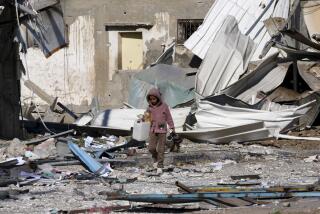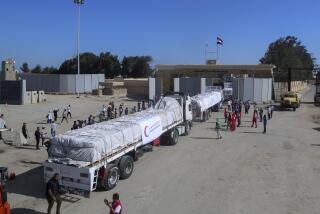Taking Charge of Tsunami Relief
- Share via
ULLE, Sri Lanka — After two weeks of dispensing medical aid, food and other necessities to tsunami victims, a clutch of relief workers, business owners and foreign philanthropists gathered in a local bar to mull some of the stickier issues facing this ravaged town.
Would standard temporary group latrines be accepted in this Muslim community, where men and women traditionally insist on separate sanitary facilities?
How could local fishermen -- many of whom are now terrified of the sea -- be coaxed back into the water to resume their livelihoods?
And how could home-building equipment and materials be delivered when the only bridge into town had been torn in half by the battering waves?
At the center of the discussion was a small team of workers from Relief International, a Los Angeles-based aid organization. Since the deadly waves struck Dec. 26, killing more than 160,000 people in southern Asia, the group has been assisting those left behind. Ulle, a town of 6,000 where up to 2,000 people are believed to have died, is one of the group’s main concerns.
Relief International has proceeded on three tracks.
First, it sent three physicians to the hinterlands of Sri Lanka to dispense medicine and note longer-term needs.
Second, it established headquarters in the capital, Colombo, to coordinate with government officials and other aid groups. The workers there amassed care packages of food and water and arranged transportation in a land where there are no highways, only narrow, congested roads.
And third, back in Washington, the group’s executive director, Farshad Rastegar, began to solicit U.S. grants for continued aid work -- even meeting with President Bush -- so that the group could still help those in need after the catastrophe faded from the nightly television news.
The group will soon launch a cash-for-work program in Ulle, financing house reconstruction and sanitation projects.
“The goal is to pay people to help themselves, to put the money in their hands,” said Jack Welch, a Relief International coordinator in Bangladesh who was the first from the group to arrive in Sri Lanka.
The program is going to pay workers an average Sri Lankan salary, which is about $80 a month.
Relief International has responded to disasters in places such as Turkey, Afghanistan, India and Iran. Although the group prefers projects that focus on women, children and minorities, each relief effort presents its own demands.
In Sri Lanka, a country with a socialized medical system where even the poorest residents receive some regular health care, the feared outbreaks of malaria and cholera have not materialized. So the group has begun working on programs in Ulle and three other communities in the eastern region of Ampara, where 185,000 people are homeless.
Even with an annual budget of less than $10 million, Relief International’s reach is wide. In Ampara, it is collaborating with Rebuild Sri Lanka, a newly formed Colombo-based aid organization.
Good fortune brought the two groups together. While traveling in Ulle, the three American doctors working for Relief International met Sivaji De Zoysa, a wealthy Sri Lankan businessman who established Rebuild Sri Lanka.
De Zoysa hadn’t planned to start his own aid group. Within days of the tsunami, he had persuaded a large British-based oil company to donate $3 million to the rebuilding cause and asked that the money be sent to three large relief groups.
But when he called the groups to learn of their plans for the funds, “they said they couldn’t tell me where the money was going,” he said. “They couldn’t even guarantee that it would be sent to Sri Lanka. So I decided to start my own relief agency.”
De Zoysa had already used his business and social connections to bring tractors, shovels and heavy moving equipment to Ulle. He liked what he saw in the three doctors and their group’s mission.
“We just clicked,” he said. “We were looking to do the same thing in the same area. It all just made sense.”
At a dinner at De Zoysa’s home, Relief International and Rebuild Sri Lanka members planned their strategy for rebuilding homes, livelihoods and infrastructure.
“This is going to work,” Welch told his host. “We have the money and the expertise, and you have the delivery system. You know the country and how the society works. This way, we know our efforts are going to reach the people who really need them.”
The leaders of the aid effort had met with local business owners and town representatives at the bar of the Siam View Hotel in Ulle.
A local hotel owner decided to work with them, launching a program to repair scores of fishing boats. He plans to take several out on an expedition to show locals that the sea is still the key to their livelihoods, not something to be feared.
If the program works in Ulle, the relief groups plan to introduce it in other villages.
De Zoysa has set to work using his government connections to ensure that the damaged bridge to Ulle is on the list of Sri Lankan refurbishment projects. Relief International engineer Henry Vagg has traveled to Ulle to help design septic tanks for homes whose outhouses were washed away.
Meanwhile, the Americans are trying to raise funds for the employment program and are instructing their Sri Lankan partners on ways to promote themselves and drum up donations.
Residents are impressed with the partnership so far.
“We’re a pretty faraway place, even for Sri Lanka, many miles from the capital. Normally, we’d worry that we wouldn’t get our share of aid,” said Andre Tissera, whose family owns the Hideaway, one of a handful of remaining hotels in Ulle.
“But after seeing what this partnership has already accomplished, I don’t think anyone feels that way. At least I don’t.”
More to Read
Sign up for Essential California
The most important California stories and recommendations in your inbox every morning.
You may occasionally receive promotional content from the Los Angeles Times.











